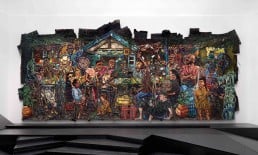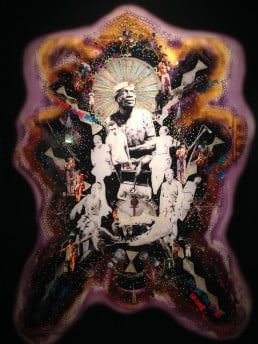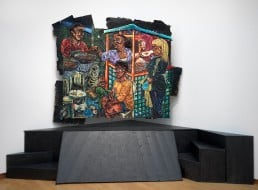Exhibitions & Fairs
A Walk Through Spirits of the Soil with Raquel van Haver
By Shira Wolfe

‘This is one of Fela Kuti’s old band members,’ Raquel van Haver tells me, pointing to the picture of an old man in one of her collages. Raquel and I are standing, surrounded by her colourful collage-work in the Stedelijk Museum in Amsterdam, where we met to talk about her impressive solo exhibition Spirits of the Soil. Her exhibition weaves together people and experiences from all over the world, including Lagos, Nigeria, Amsterdam Southeast, London, Cuba, Trinidad and Tobago, Zimbabwe, and Colombia. Raquel walks me through the exhibition, starting in the first room filled with collages exploding with colourful details and fragments, which draw on her photography project in Lagos.

Raquel elaborates on the story behind the collage with Fela Kuti’s band member: ‘Towards the end of my stay in Lagos my fixer brought me to this place where all these old musicians were smoking and chilling on the roof terrace. And once I got there I stayed for ages, because they were so chill! In the end, the work shows the vibe of the music from Lagos, and this piece is like a tribute to all those musicians.’
The pieces hanging here are actually prints of the original collages. The originals are a bit larger than the prints, usually containing around 15 layers in one collage. Raquel explains that her collages draw on the same ideas as her paintings, layer upon layer, but she wanted to make these collages seem flat by making prints. ‘It looks super absurd this way,’ she says. ‘There are chains, beads, all kinds of things.’ And the originals? ‘They’re hanging in my living room as partitions! I’m just saving them, but I don’t want to do anything else with them.’
Other recurring elements in her collages are African masks that she saw every day during her time in Lagos, and wheelchairs. When I ask her about these wheelchairs, Raquel tells me you see them all over Lagos – many people suffer from various injuries and diseases like polio, and it’s a very common sight to see two kids begging, one sitting in the wheelchair, the other one pushing it along.
The collage-work allows Raquel to return to a childlike freedom, connecting elements in a playful, dreamy state. In terms of her paintings, she describes her practice as ‘painting towards each other,’ by which she means having the freedom to bring different people and different places together. That’s what Raquel aims to do in her work – to bring together people whom she’s met in different countries, in different places, and in different settings.
The large paintings are hung chronologically, starting with Dem Smoke and Blaze under Royal Regime, and ending with her largest, most imposing piece – We Do Not Sleep As We Parade All Through The Night. Each painting contains more movement than the last, with characters who seem to be inviting you into their world while jumping out into yours. ‘You can see how it’s getting bigger and bigger, they’re exploding outwards more, there’s more movement,’ Raquel notes as we move from one painting to the next. ‘With the largest canvas I just had the freedom to go wild,’ she adds, referring to We Do Not Sleep… This 4 by 9 metres wall-to-wall masterpiece, loosely modelled after Da Vinci’s The Last Supper, portrays an exuberant group of people around a table eating, drinking and playing cards. It’s like a contemporary genre painting, a whirlwind of everyday life – here sits a mother with her child on her lap, over there a man holding a birdcage appears to be in the midst of negotiations, someone else is tossing the playing cards in the air while little kids hide beneath the table and a dog is searching for food…
When asked if it’s hard to know when a painting is finished, Raquel responds matter-of-factly: ‘Not really, because usually exhibitions and commissions create natural time constraints and deadlines. I have a very clear idea of what I have to finish every day, and I know how fast I work and how much time is needed for the paint to dry. So I make sure that I have such a clear structure of what I need to do that I finish it on time. Of course, I always see areas on the canvases that I’d like to add to or touch up even more, but when it’s full it’s full.’
Raquel puts all kinds of objects in her paintings – Nollywood posters, posters for parties and events that she finds on the street in Amsterdam Southeast, beads, fake hair, cigarette butts, mobile phones… Not to mention the layered texts in the canvases. ‘I don’t know why exactly,’ she says, ‘but I really wanted those little bead eyes in the paintings,’ referring to the small blue bead eyes staring out at you from the canvas. The eyes mesmerise throughout her work – in the collages many of the people’s eyes are covered with crystals, while in the large-scale paintings the eyes are like wells, which seem to be so filled with emotion and experience that you’re almost sucked in. ‘That’s because they’re so open,’ Raquel explains.
We enter the last exhibition space where Raquel meets the museum’s art restorer – they have an appointment to make a minor adjustment to one of the paintings. Raquel also talks her through how to take down the gigantic painting We Do Not Sleep As We Parade All Through The Night when the exhibition ends in April, her magnificent centrepiece which the Stedelijk Museum purchased for their collection. It’s so large that they were initially worried it wouldn’t fit through the door of the exhibition space when they were setting up the show.
And then Raquel is off to pack for her upcoming research trip in South Africa and I’m already halfway to my bike when I instead decide to head back into the museum to spend some more time with her work – pieces including The eyes must be Obeyed… One 1000 Soldiers with One 1000 Dices, which could be a family scene in a bar where the text ‘You or I’ is hidden between the bartender’s bottles; One Drop… Your Heart Might Skip a Beat for Many Reasons, which shows percussionists and dancers in full swing while two white doves fly over their heads; and one of my personal favourites Life never Sweet like a Chocolate Vanilla, portraying a glowing scene of women preparing meals from their street cart. ‘That title was inspired by the lyrics of a Chronixx song,’ Raquel had told me. Long after I’ve left the museum, the titles of Raquel’s paintings and the faces of her characters continue to swarm in my head like melodies on a warm summer’s night.

Raquel van Haver’s solo exhibition Spirits of the Soil is on view at the Stedelijk Museum Amsterdam through 7 April 2019. For more about Raquel, check out our interview with her here.
Museum
Stedelijk Museum Amsterdam
Opening year
1895
Opening Times
Daily: 10 am – 6 pm
Friday: 10 am – 10 pm
Address
Museumplein 10
Amsterdam, The Netherlands







